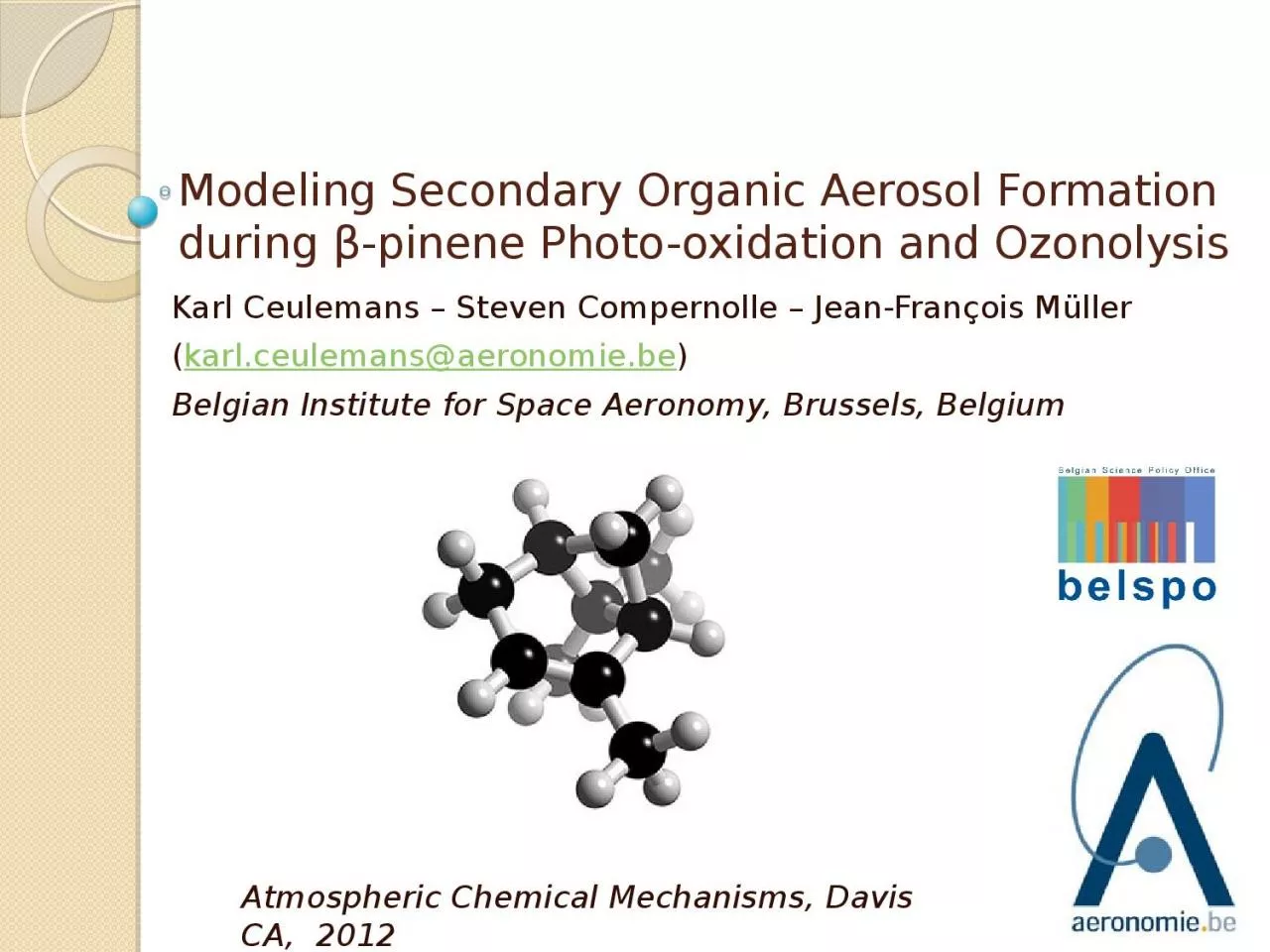

Aerosol Formation during β pinene Photo oxidation and Ozonolysis Karl Ceulemans Steven Compernolle JeanFrançois Müller karlceulemansaeronomiebe ID: 932652
Download Presentation The PPT/PDF document "Modeling Secondary Organic" is the property of its rightful owner. Permission is granted to download and print the materials on this web site for personal, non-commercial use only, and to display it on your personal computer provided you do not modify the materials and that you retain all copyright notices contained in the materials. By downloading content from our website, you accept the terms of this agreement.
Slide1
Modeling Secondary Organic Aerosol Formation during β-pinene Photo-oxidation and Ozonolysis
Karl Ceulemans – Steven Compernolle – Jean-François Müller (karl.ceulemans@aeronomie.be)Belgian Institute for Space Aeronomy, Brussels, Belgium
Atmospheric Chemical Mechanisms, Davis CA, 2012
Slide2Outlineβ-pinene as biogenic source of SOABOREAM: Detailed model for biogenic SOAExtension of BOREAM to β-
pineneComparison against experiments:Gas phase chemistrySOAPhotochemical aging of β-pinene SOA
Slide3β-pinene: atmospheric relevance Global biogenic SOA: 17-107 Tgy-1 (Lin et al. 2012)Global
monoterpene emissions: about 70 TgCy-1 (Tanaka et al 2012)β-pinene: among most
emitted, behind α-pinene (Geron
et al.2000)Models often
lump monoterpenes
for
SOA
What
are different monoterpenes’ contributions?Differences in impact of photo-chemical aging? reducing uncertainty on modelled biogenic SOAβ-pinene SOA among most studied
Contribution
of
monoterpenes
to
SOA,
estimated
with
CTM IMAGESv2
(
preliminary
result
)
Slide4BOREAMBiogenic hydrocarbon Oxidation and Related Aerosol formation Model Previously
focused on α-pineneGas phase reaction model based on theoretical calculations and SARs, additional generic chemistry and
aerosol formation module15000 reactions, 2500 species, using KPP (Sandu
et al. 2002)
SOA
yields
predicted
reasonable
well for α-pinene smog
chamber
experiments
(Ceulemans et al 2012)
Slide5Parameterization for α-pinene SOA
Based on detailed model BOREAM, long runs including SOA ageingConsiders impacts of NOx, temperature, type of oxidant, RH Full BOREAM and parameter model agreement validated through realistic ambient box model scenarios (generated with CTM IMAGES)
Good agreement overall
Ceulemans
et al. (2012), ACP
298 K
Slide6β-
pinene
:
ozonolysis
mechanism
2 primary
ozonides
d
ecomposition to
CI-1+ CH2O (48.8%)CI-2 + CH2O (46.2%)nopinone + CH2OO (5%)CI-2:SCI-2 (20.6%)dioxiranelactones (17%), biradical(10%)biradical RAD-3 (2.0%)CI-1: SCI-1 (16.2%) hydroperoxide
channel (28.3%)
Theoretical
study
of the gas-
phase
ozonolysis
of
β
-
pinene
T.L. Nguyen, J. Peeters, L.
Vereecken
Phys
.
Chem
.
Chem
.
Phys
., 2009,11,5643-5656
Nguyen et al. (2009)
Fig.6
Slide7β-pinene ozonolysis mechanism: biradicals
Formation of biradicals: RAD-3 (3% yield, see Nguyen et al. 2009)Biradical from decomposition of dioxiranes(possibly10% yield)
detailed treatment of possible reactions included in BOREAM, based
on SARs for peroxy/alkoxy
/alkyl radicalsRemains speculative and needs further theoretical/experimental verification
Functionalized products
Slide8β-pinene ozonolysis mechanism: acid formation
Pinic acid formation: not theoretically explained yetPresumed to originate in hydroperoxide channel (for example: Jenkin, 2004)We include a yield fitted against the pinic acid yield of Yu et al. (1999), about 3.5% total yield
from β-pinene
Slide9β-pinene: OH oxidation mechanism
Major pathwaysOH-addition on Ca and Cb (83.3% and 6.8%)H-abstraction from Cc and Cd (5.9% and 3.%) New chemistry for major OH-addition product
A ring opening of alkyl radical BPINOH1*Peroxy-radical R1OOHigh-
NOx
: reaction with NO followed by ring closure of alkoxy radical
Low-
NO
x
: ring closure of
peroxy radical
A
t
heoretical
study
of the OH-
initiated
gas-
phase
oxidation
of
β
-
pinene
: first
generation
products
, L
.
Vereecken & J. Peeters, Phys
. Chem. Chem.
Phys
., 2012,14,3802-3815
Slide10BOREAM: Generic chemistrySecond generation oxidation products lumped into semi-generic and generic products
Semi-generic: carbon number and
functional groups
Generic: carbon
number, vapour pressure classes (11) and 1explicit
functional
group
LA10HPP
10
carbons1 alcohol &2 hydroperoxide
Implicit
parent structure, with pvap,im
LX9cONO2
Slide11β-pinene: some previous modelling
resultsChen & Griffin 2005:Shown is fig. 1, experimental and modeledβ-pinene
, O3, NO, NO2 fromthis paper
Jenkin (2004) for SOA Pinho et al. 2007:
gas-phase, using MCM3.1:
Fig.9
showing
D(O
3
-NO) in ppm for Carter (2000)
Slide12β-pinene gas phase chemistry: ozoneBOREAM: overestimates ozone, adding O(3P) channel improves thingsLess SCI-decomposition
further improves, but more testing neededβ-pinene oxidantOH: 47.8%O
3: 26.8%O(3P): 20.9%NO3: 4.5%
Slide13β-pinene SOA: Photo-oxidation
BOREAM: reasonable agreement, overestimated up to 20% near endLow-NOx photo-oxidation: few experiments available for validation
Ng et al., 2006 (high NO
x)S
aturated vapor pressure estimation methods:EVAPORATION or Capouet
-Müller(2006)
See poster by Steven
Compernolle
Slide14β-pinene photo-oxidation: SOA composition (high-NOx)
Molar composition for Ng et al. (2006) after 2 hours:BOREAM SOA is dominated by nitrates and peroxy acyl nitrates (PANS), some contribution of
hydroperoxidesAuld & Hastie (2011): nitrates, some with mass 231 detected
Slide15β-pinene SOA: ozonolysis
Pathak et al. (2008) (low NOx, dark OH scavenger ozonolysis)BOREAM: reasonable agreement SOA for most temperatures, except at 40°C unknown chemical pathways activated at high temperature?SOA model temperature dependence slightly overestimated (similar as for α-
pinene)
Slide16β-pinene ozonolysis: Sensitivity of SOA yield to chemistry
Biradicals: important for SOA, lead to many functionalized speciespinic acid important SOA contributorSome SCI-oligomers formed through SCI + molecular products (few %), though they don’t increase SOA yields strongly in this case
Slide17Photo-oxidative aging: comparison β
-pinene vs. α-pinene
14-day OH-oxidation scenarios (ozonolysis switched off)
low-NOx: slightly higher yields for β
-pinene than
for
α
-pinene high-NOx: significantly higher yields for β-pinene than for α-pinene high contribution of generic species in SOA + generic chemistry more uncertain
larger model uncertainty
Slide18ConclusionsBOREAM extended to β-pinene, based on recent theoretical mechanismsGas-phase chemistry: ozone formation too high at later stages: more validation neededSOA:generally agrees reasonably for
ozonolysis, except at high temperatures (40°C)agrees for some photo-oxidation experiment, more comparisons necessary (solar radiation,low-NOx)First tests: photochemical aging through OH-oxidation leads to more SOA for β-pinene than for α
-pinene
Slide19Thank you for your attention!